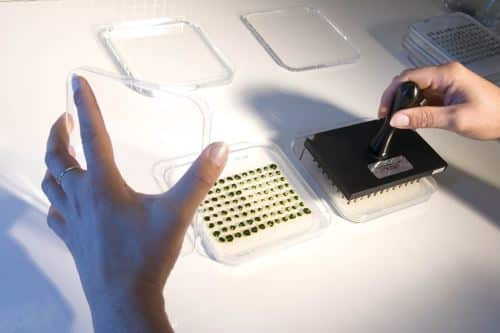PRESS RELEASE
In 2017, CEA researchers discovered an enzyme with a rare property: activated by light, it enables microalgae to convert their fatty acids directly into hydrocarbons. Today, together with the Institut Polytechnique de Paris, they have succeeded in understanding and demonstrating that this “FAP” enzyme can produce gasoline-type hydrocarbons, thanks to an auto-catalytic effect.
Climate change is stimulating research, particularly to develop alternatives to fossil fuels. This is the case for the photocatalytic conversion of fatty acids from microalgae into hydrocarbons, which represents a promising route to the production of green fuels and other high-value compounds. Indeed, like plants, microalgae use CO2 to ultimately synthesise their fatty acids, making the overall process carbon neutral.
In 2017, BIAM researchers discovered an enzyme in the micro-alga Chlorella variabilis with a rare property: activated by sunlight, it allows micro-algae to convert their fatty acids directly into hydrocarbons. Since then, this fatty acid photodecarboxylase (FAP) has mobilised the international scientific community to deploy its full potential in the development of new products.
To deploy its full potential in the production of biofuels such as diesel. However, the supposedly low activity of this enzyme on C2-C12 fatty acids seemed to exclude its use for the synthesis of medium-chain hydrocarbons such as petrol. Remember that hydrocarbons are organic compounds made up of a carbon chain (C) and hydrogen atoms (H).

An auto-catalytic effect that increases the conversion yield of gasoline-type hydrocarbons
Today, the BIAM, Joliot and Institut Polytechnique de Paris teams have revealed that the FAP enzyme is more effective on a fatty acid with eight carbon atoms. They have observed in vitro that it can convert octanoic acid (C8) four times faster than hexadecanoic acid (C16), the most efficient substrate identified to date. This performance has also been observed in vivo, as explained by Pavel Müller, a researcher at CEA-Joliot who used time-resolved spectroscopy: “When FAP decarboxylates octanoic acid (C8) in a reaction that produces n-heptane, this n-heptane remains in the binding pocket and mimics the missing part of the long chain, thus helping to increase quantum yield. This autocatalytic effect makes the photodecarboxylation of medium chain fatty acids (such as C8) almost as efficient as that of native long substrates. In addition, the replacement of the product by a new substrate is faster for medium chains than for long ones.” This results in a tenfold higher rate of FAP production for n-heptane (C7H16), which is a gasoline-like hydrocarbon, than for n-pentadecane (C15H32).
“These results represent an important step towards the production of gasoline-like hydrocarbons from a biological source and light. We remain fully mobilised to continue to optimise the FAP enzyme, which has not finished revealing all its secrets,” concludes the researcher.
REFERENCES
Authors : Poutoum P. Samire, Bo Zhuang, Bertrand Légeret, Angel Baca-Porcel, Gilles Peltier, Damien Sorigué, Alexey Aleksandrov, Frédéric Beisson, Pavel Müller